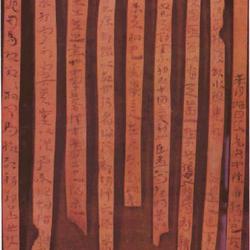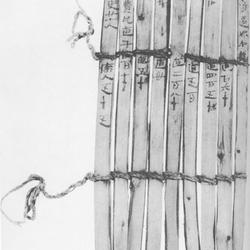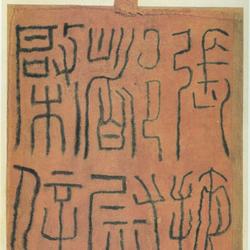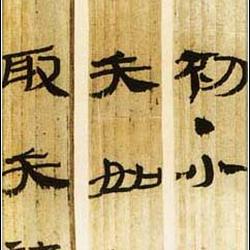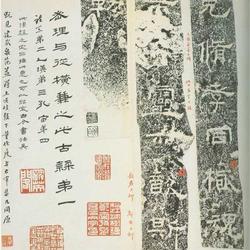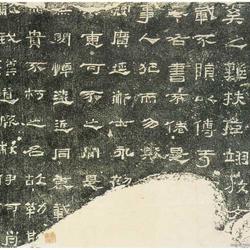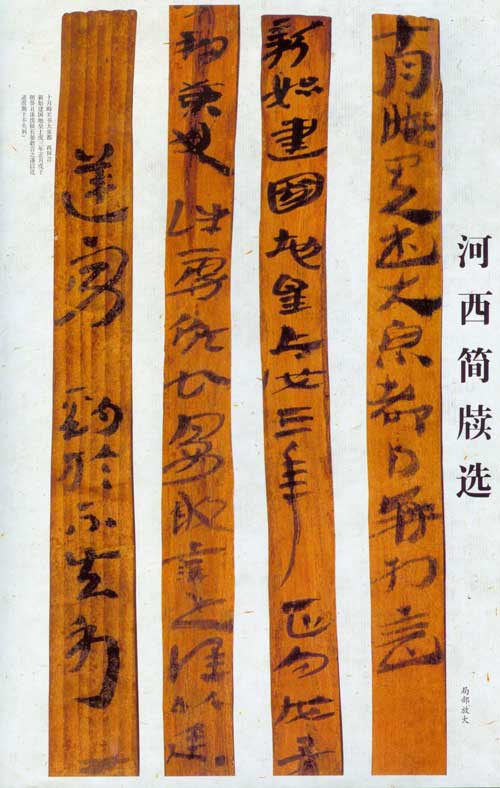
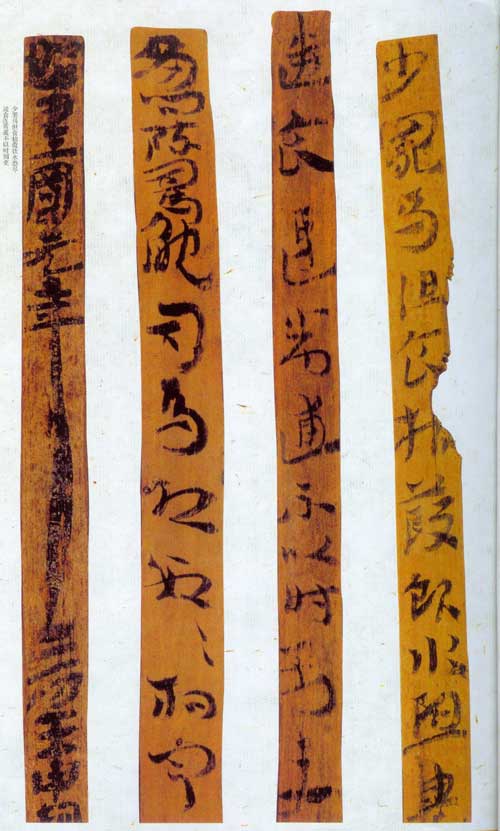
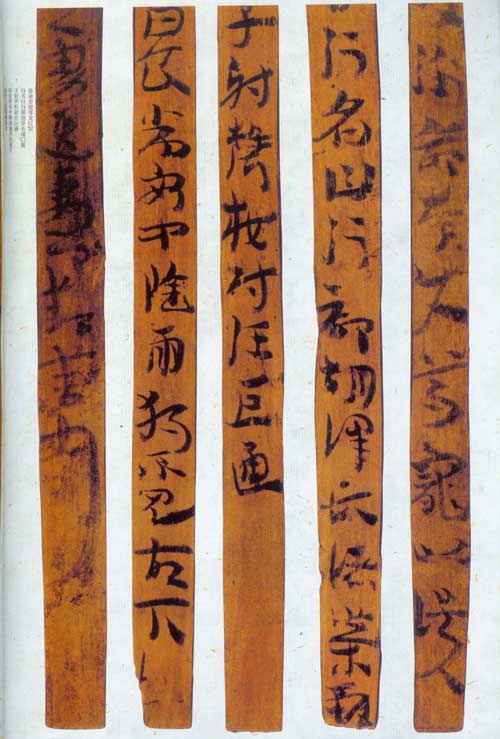
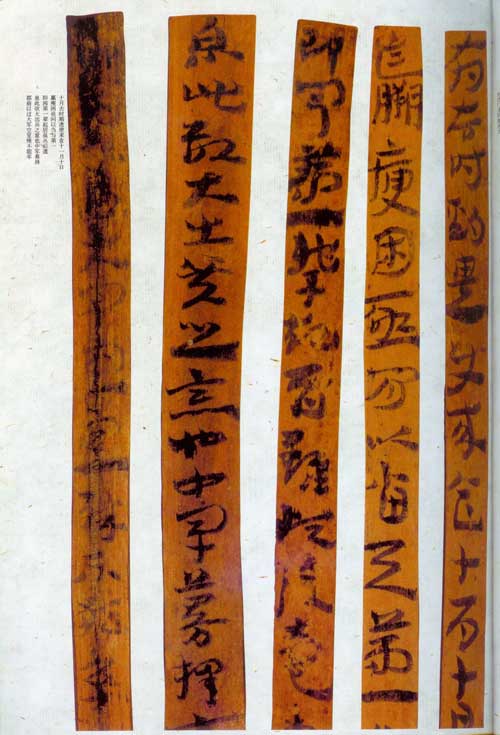
The main landform of the Hexi region is the Gobi Desert, with the Qilian Mountains stretching thousands of miles from east to west to the south, and the Tengger Desert to the north. Seasonal runoff from the Qilian Mountain glaciers in spring, summer and autumn nourishes the lowlands in the corridor area, forming a rich and beautiful oasis. The Gobi Oasis is dry and windy with little rainfall and relatively harsh geographical conditions, forming a good environment for protecting ancient relics.
During the period of Emperor Wu of the Western Han Dynasty, in order to eliminate the long-term threat of the Xiongnu in the northwest, he sent troops to the border areas and fields in Hexi. With the management of this area by the Han Dynasty, a large number of bamboo slips and written documents appeared. These documents were well preserved under the special natural conditions of Hexi. protection of. Today, the Hexi region has become one of the richest collections of ancient Chinese bamboo slips.
The earliest discoverer of Han Dynasty bamboo slips in Hexi was British-Hungarian Mark Aurel Stein. During his second trip to Central Asia (1906-1908), he discovered the ruins of Han Dynasty beacons and city barriers in the delta area of the lower Shule River northwest of Dunhuang. Later, the beacons of the Han Dynasty were traced upstream along the banks of the Shule River to the northeast of Dunhuang, where they found the Great Wall of the Han Dynasty consisting of fortress walls, beacons, and city barriers. Seventy-five Han bamboo slips were excavated from the beacon sites of the Han Dynasty. Among them, there are 166 chronological slips, the earliest is from the third year of Tianhan, Emperor Wu of the Western Han Dynasty (98 BC), and the latest is from the second year of Yonghe, Emperor Shun of the Eastern Han Dynasty (137). From 1913 to 1915, Stein conducted his third expedition to Central Asia. He followed the Han Dynasty frontier fortress beacon ruins in Dunhuang eastward, passed through Anxi and Jiuquan to Jinta, and in this section of the Han Dynasty beacon line One hundred and five Han bamboo slips were obtained from the ruins.
From 1927 to 1931, the Northwest Scientific Research Group unearthed more than 11,000 slips in the Juyan area of the Ejina River Basin.
In 1944, the Northwest Scientific Expedition followed Stein's expedition route and re-investigated the beacons along Yumen Pass, Yang Pass and the Han Dynasty frontier fortress. Mr. Xia Nai and Yan Wenru excavated the small square plate site in the northwest of Dunhuang and obtained forty-nine slips from the Han Dynasty, and verified that the small square plate in the northwest of Dunhuang was the Yumen Pass of the Han Dynasty.
From 1972 to 1976, the Gansu Provincial Museum, the Jiuquan area and the local garrison jointly formed the Juyan Archaeological Team to conduct an excavation of the Han Dynasty Jiaqu Houguan, Fourth Sui, and Jianshui Golden Pass sites in Ejina Banner. Through investigation and excavation, more than 20,000 Han bamboo slips were obtained. The earliest date in this batch of bamboo slips is the second year of Tianhan (99 BC), the reign of Emperor Wu of the Western Han Dynasty, and the latest is the eighth year of Jianwu (32 AD) of Emperor Guangwu of the Eastern Han Dynasty.
In 1977, the Jiayuguan Municipal Cultural Administration Office investigated and cleaned up a Han Dynasty beacon site near Yumen Huahai Farm and obtained 91 Han bamboo slips.
In 1979, when the Gansu Provincial Institute of Cultural Relics and Archaeology inspected the Han Dynasty beacons near Dunhuang, they discovered a beacon in Maquan Bay, 11 kilometers west of Xiaofangpan, that had not been registered during Stein's inspection. After excavation, more than a thousand bamboo slips from the Han Dynasty were obtained.
During a cultural relic survey in 1987, the Dunhuang Museum discovered the Xuanquanzhi ruins in Xiaogu County during the Han Dynasty. After three years of archaeological excavations by the Gansu Provincial Institute of Cultural Relics and Archeology since 1990, the architectural ruins of the Xuanquan Station, which consists of docks, houses, stables, and warehouses, were completely revealed, and tens of thousands of Han Dynasty slips were obtained. .
Although the above bamboo slips unearthed from the Han Dynasty frontier fortress sites are different in width and have single and double lines in writing, the lengths are all made according to the Han Dynasty's one foot, which is about 23 centimeters long.
The tombs of the Han Dynasty in the Hexi area have the same funeral concepts and systems as those in the Central Plains area, but the climate is dry and the soil has good air permeability, which is more conducive to the preservation of slips, silks and other funerary objects. Therefore, slips and slips were also unearthed from Han Dynasty tombs in Hexi.
In 1957, ten wooden slips were unearthed from Tomb No. 8 of Mozuizi in Wuwei, Gansu Province. The content is an edict from the Han Emperor to care for the elderly and give the elderly a dove stick.
In 1959, 469 "ritual" slips from the Han Dynasty were discovered in Tomb No. 6 of Mozuizi, with a total of nine chapters. There are three kinds of "ritual" books in the tomb. Among them, there are 398 copies of Type A, seven chapters, 56 centimeters long and 0.75 centimeters wide, which is equivalent to two feet and four inches of Han ruler. It was stipulated when copying the Six Classics in the Han Dynasty. The length of the slips.
In 1972, the Gansu Provincial Museum cooperated with the Wuwei County Cultural Department and unearthed a batch of medical slips from a Han tomb on Dry Tan Slope, ten kilometers southwest of Wuwei City. There were 78 slips and 14 slips. , a total of ninety-two pieces. The length of the brief is 23.2 centimeters, and it is one Chinese foot long. It is a ruler book. There are two types of medical tablets. One is one centimeter wide and has wedges on the sides. The contents of the tablets include medical prescriptions for internal medicine, surgery, gynecology and facial features, as well as acupuncture techniques and contraindications. The other type is 0.5 centimeters wide and has no wedges on the sides. It contains medical prescriptions for treating various diseases and difficult diseases. The width of the tablets varies from one centimeter to four centimeters. The front and back are written in ink, and some are damaged. Each side is usually written with two or as many as six lines. These medical slips are written in official script or cursive script, and the calligraphy style is very distinctive. Therefore, it is not only a precious ancient medical prescription material, but also a treasure of ancient calligraphy art.
In 1981, when the Wuwei County Cultural Relics Management Committee was investigating key cultural relics in the county, Yuan Deli, a villager in Bangshan, Xinhua Township, handed over the "Wang Mei's Edict" tract unearthed in Mozuizi, of which there are 26 in existence.
In 1971, the Gansu Provincial Museum discovered 23 wooden slips in a Han tomb in Gangu County. The bamboo slips are 23 inches long and 2.6 centimeters wide. They are made of pine wood. Each bamboo slip has two lines. The serial number is written on the top of the back and is written after the series is compiled into a volume. The bamboo slips are neatly divided into three sections, and the neat and beautiful eight-part characters can be clearly recognized, but most of the slips are in pieces.
In 1986, the Gansu Institute of Cultural Relics and Archeology discovered more than 480 bamboo slips in Tomb No. 1 of the Fangmatan Ancient Tombs in Beidao District, Tianshui City. The bamboo slips were soaked in the coffin liquid and decayed severely, turning black, and the characters on the bamboo slips were full of water. There are two types of bamboo slips: type A is 27.5 cm long and 0.7 cm wide; type B is 23 cm long and 0.6 cm wide.
Comparing the bamboo slips unearthed from the tomb with those unearthed from the Hexi frontier fortress site, the length of the slips unearthed in the tomb has its own specific size depending on the style of the slips. The contents are edicts, laws, scriptures and medicines that the owner of the tomb believes are worthy of permanent collection. Fang et al. The writers of the slips all had profound calligraphy skills and carefully transcribed them. Every word in each slip embodies the characteristics of the times.
Hexi bamboo slips have special value in the study of the evolution of Chinese characters and the origin of calligraphy styles, mainly in the following two aspects: First, they occupy an important position in the study of calligraphy history and the origin and evolution of calligraphy styles. Through careful analysis and study of the types of calligraphy in bamboo slips, we can better understand the historical production and development process of various calligraphy styles and their mutual relationships; secondly, the value of Han bamboo slips in calligraphy art and aesthetics . Through the exploration of bamboo slip calligraphy, people can have a deeper feeling and understanding of the basic style of Chinese calligraphy art and the true meaning of calligraphy aesthetics.
The Hexi bamboo slips show the evolution and development of official script in a rich and detailed style. The origin of official script can be traced back to the Warring States Period. "Since the Qin Dynasty used seal characters, there were many affairs in the Qin Dynasty, and it was difficult to write seal characters, so they ordered the official to assist the calligraphy, which was called the official character" ("Wei Heng's Four Style Calligraphy Trends of the Western Jin Dynasty"). The popular saying about the creation of the official script was written by Cheng Miao, "In the beginning, Miao was imprisoned in Yunyang Prison for his crime. After Tan thought for ten years, he changed the seal script into the official script and got three thousand characters. In one day, the First Emperor praised him for his kindness and acquitted him of his crime. Used as censor... This is the beginning of the world" ("Xuanhe Lipu·Narrative"). Official script is convenient for writing and is beneficial to the people. In the Han Dynasty, due to the wide application and further modification of official script among the people and lower-level officials, official script became more perfect and finally became the universal calligraphy style in the Han Dynasty.
The calligraphy circle has always divided official script into two types: ancient official script and eight-part script. These are two different stages of development. Ancient Li is the predecessor of Bafen. The character shape is quite close to that of seal script. It has the writing method of seal script, but it is thick and simple. The structure is square with circles, the strokes are round with square folds, there are pauses and lifts, and there is a slight The wave is picky and the brushwork is rigorous, elegant and beautiful. Bafen refers to the official script with a square structure and obvious strokes and strokes, which is what people usually call Han Li. There is a fundamental difference between ancient official script and seal script, because official script "uses stroke symbols to destroy the structure of pictographic characters, turning them into pictographic characters that are not pictographic" (Wu Bai's "Looking at the Early Qin and Han Official Scripts from Unearthed Qin Bamboo Bamboo Scripts"). This is the fundamental development of Chinese characters and Chinese calligraphy from complexity to simplicity, from pictography to abstraction, and from appearance to ideograms. In the Hexi region of Gansu, there are not only the exquisite Fangmatan bamboo slips in Tianshui, Dunhuang and Juyan, but also the ancient official slips in the Western Han Dynasty. For example, the calligraphy goblet unearthed from Maquanwan, Dunhuang, has a seal meaning in the shape of the characters and the brush strokes. There is no obvious wave force or picking method, but the structure has changed greatly. Square brushes are used, and the strokes are mostly horizontal. The strokes are thick and thin, and the strokes are linear. Simple disease. The ancient official records of the Han Dynasty in the Hexi bamboo slips are of great significance for understanding the development trajectory of the ancient official officials to the eight points.
Kang Youwei once advocated that during the Western Han Dynasty, "there was absolutely no li style of the Later Han Dynasty", "for example, there was no Xiping li style before the Western Han Dynasty, and there was seal style before He Di." (Kang Youwei's "Guang Shi Zhou Shuang Ji") Recent people have even more clearly stated that "the official style of Bo Shi did not mature until the Eastern Han Dynasty" (Guo Shaoyu's "Glimpsing the Evolution of Typefaces from Calligraphy"). There are also those who advocate that "official script developed in the late Western Han Dynasty and reached a mature stage" (Wang Jingxian, "The Art of Calligraphy in Qin and Han Dynasties"). At what age did Han Li become fully mature and standardized? This is a long-standing debate in the history of calligraphy. Judging from the Dunhuang Maquanwan Han bamboo slips, a large number of formal documents are in mature official script with characters tending to be flat, with "silkworm heads and swallow tails, inverted in and flat out". For example, the shape of the glyph on a goblet from the second year of Emperor Xuan of the Western Han Dynasty is particularly obvious, which is another example of the maturity of official script in the middle of the Western Han Dynasty. The newly discovered Xuanquan slips in recent years clearly show that regular and perfect official script was produced during the Taishi reign of Emperor Wu in the mid-Western Han Dynasty. This is an important correction to the late Western Han Dynasty and Eastern Han Dynasty theories of official script popular in the calligraphy circle.
The discovery of a large number of cursive scripts on Han bamboo slips in Dunhuang, Juyan, and Wuwei is of great value for studying the formation and development of cursive script in the Han Dynasty. Xu Shen said that "cursive script emerged in the Han Dynasty" ("Shuowen Jiezi·Xu"). Cursive script in the Han Dynasty was developed based on official script. The early cursive script was a simple and rapid writing method of the ancient officials of the Western Han Dynasty. "In the past Qin Dynasty, the princes were vying for superiority, and simple messages were passed down from generation to generation. They were waiting for the beacon to go to the post. They could not save the time with seal script and official script, so they wrote a letter to go to the emergency. This is the basis of today's cursive script." (Liang Wu Emperor Xiao Yan's "Cursive Script" "), which is the so-called "Zhangcao is the speed of official script, and grass is the speed of Zhangcao" (Zhang Huaiguan's "Shujuan"). This kind of cursive script is called Caoli or Licao. With the development of Cao Li, Zhang Cao appeared with ripples and broken meanings. The name Zhangcao was first seen in Zhang Huaiguan's "Shujuan": "When I presented it to Bai Fu, he said: The ancient Zhangcao is not grand and elegant. It is a sudden change from the true form and combines the principles of poor pseudo-strategy. It is extremely traced and is not as good as Gao Xing. In the past, the law is definitely different, so you should change the style." Regarding the origin of Zhangcao, there are three main theories in the literature: one is that Shi You of the Western Han Dynasty Yuan Dynasty wrote Zhang Cao: "The Emperor Yuan Dynasty of the Han Dynasty wrote "Jijiu Zhang", Disbanding the official script and writing it simultaneously, the Han customs are simple and lazy, and gradually they are implemented." (Zhang Huaiguan's "Shu Duan") One kind is Zhangcao written during the reign of Emperor Zhang of the Eastern Han Dynasty. (Ning Chenen's "Shu Yuan Essence" quotes Tang Cai Xizong's "Dharma Calligraphy") One is to say that Du Du wrote the chapter. (Tang Dou's "Shu Shu Fu") The above-mentioned documentary records have greatly affected the calligraphy community. It is believed that Zhangcao was formed at the end of the Western Han Dynasty and matured in the Eastern Han Dynasty. The Hexi bamboo slips specifically reflect the development process from Caoli to Zhangcao. Among the Juyan Han bamboo slips from the period between Emperor Wu of the Western Han Dynasty and Emperor Yuan, some of the bamboo slips are written in quick and simple cursive style with the dissolution of official script, while some are written in Zhangcao with a strong cursive style. By the time of Emperor Cheng of the Western Han Dynasty, mature bamboo slips had appeared. The chapter cursive indicates that the chapter cursive has formed a stereotyped font. Among the Han bamboo slips in Maquanwan, Dunhuang, the books, volumes, and slips from the period of Emperor Xuan of the Western Han Dynasty and the manuscripts of memorials from the period of Wang Mang are already mature chapters. The scripts of the bamboo slips from the period of Emperor Xuan's Wufeng period are also mature chapters. This proves that the maturity of Zhangcao should undoubtedly be in the middle of the Western Han Dynasty. Cursive script of the Han Dynasty, especially Zhang Cursive, is a wonderful work of ancient Chinese calligraphy and has high artistic value. It marks the beginning of calligraphy becoming an art that can express emotions with a high degree of freedom and express the calligrapher's personality. However, for a long time in the past, Zhangcao script was only seen in copies and engravings, and the original appearance of Han Dynasty Zhangcao could not be seen. In modern times, a large number of Han Dynasty bamboo slips were unearthed, and its original appearance was reappeared, and the calligraphy that had been buried for more than 2,000 years was revealed. The reappearance of artistic treasures adds a glorious page to the history of ancient Chinese calligraphy.
The basic style of Hexi bamboo slips can be summarized as straightforward, simple, rough and strong. The "eight-character" characteristics of Hexi bamboo slips and calligraphy were formed due to factors such as the unique era, military missions and living environment. Most Most of the Hexi bamboo slips were found in the beacon ruins of Dunhuang and Juyan frontier fortresses in the Han Dynasty. The drafters and transcribers of these documents were mostly lower-level officials in the frontier fortress military defense system and postal service system. The ancient Li , Bafen, Licao, Zhangcao and other fonts that appear on Han bamboo slips were created by these lower-level officials and people based on the needs of the military situation, practicality, and for the convenience of writing. They "simple" seal script and ancient official script to create official script, which was developed from official script. The real practitioners of the evolution of calligraphy style are this group of unknown calligraphers. They are more innovative and enterprising in their thinking and less rigid in their calligraphy style. It must be free and easy, natural and smooth, simple and unsophisticated, without the temple customs of elaborate carving, tracing heads and corners.
Time and region are important reasons for the unique calligraphy style of Han Dynasty bamboo slips. The area where the Hexi bamboo slips were unearthed was the northwest border of the Han Dynasty, which was the focus of social and ethnic conflicts at that time and where the Han Dynasty focused its political, military and economic operations. At that time, the Dunhuang and Juyan border fortresses were outposts to resist the Huns' invasion. Many border guards left their hometowns and stayed in the Gobi desert for months and months, eating and sleeping in the open air under the stars and the moon. Such an objective environment has tempered people's bravery and pioneering spirit, and forged their strong and bold character. The rough and vigorous calligraphy style left on the Han bamboo slips is a true reflection of their spiritual realm. The exquisite works of official script and Zhangcao shown on Han bamboo slips were produced in this way.
The strength of calligraphy comes from the use of the pen. The expression of pen power is one of the basic characteristics for the survival of calligraphy art. The backbone and charm of calligraphy art are produced in the use of pen and ink, that is, "it is only to seek its strength, and the form will come from itself" (Li Shimin's "On Calligraphy"). It is an important part of the formal beauty of Chinese calligraphy. The characteristics of the official script and cursive script of Hexi bamboo slips are the combination of square and round, and the alternation of sharp edges. Both square and round pens are used. The two are cleverly combined and serve each other. Both center forwards, side forwards and reverse forwards are used, and the forwards are used alternately to show their strengths. As a result, the calligraphy style of Hexi bamboo slips is sometimes free and easy, natural and smooth; sometimes it is rough and aggressive, full of wild interest; sometimes it is vigorous and vigorous, vigorous and vigorous, forming a vivid pattern with various expressions and postures, each showing its own beauty. Ju Yan's Han bamboo slips are reversed and straightened out, and the brush is hidden and sharp, so that every point and every stroke contains muscles and bones, and the strength is in it. Some of the vertical paintings in the simple book flow freely, and the heavy ink rough painting at the end of the pen is like a spear or a halberd, standing upright like a big tree, showing the majestic brushwork and strong beauty of the pen.
Calligraphy art is line art. In ancient times, the first person to use lines to create text graphics and express the meaning of words was my country's first calligrapher. Without the creation of the first person, there would be no Chinese characters and no traditional Chinese calligraphy art. With the passage of time, the five main calligraphy styles of seal, official script, regular script, cursive script and running script came into being. The Han Dynasty was an era when official script and cursive script were popular. Official script and cursive script were line arts that could more freely express emotions and express the calligrapher's personality. Chinese characters are composed of various lines. These countless lines can be ever-changing, such as square and round, curved and straight, long and short, thick and thin, thick and light, light and heavy, slow and fast, sparse and dense, empty and empty. and real, oblique and straight, skillful and clumsy, etc. In the calligrapher's pen, some of these lines are as heavy as falling rocks , some are as light as flying flowers, some are as hard as chisel iron, some are as fast as lightning, and some are as soft as buds. The various changes in the brushwork, structure, and composition of Hexi's bamboo slips and calligraphy art are ultimately the changes in line shapes and combinations. The changes in brushwork, structure, and composition form the characteristics of Hexi's bamboo slips and calligraphy. Therefore, lines are the essence of Chinese calligraphy art. Calligraphers use their works to reflect nature and society. The link that connects the artistic beauty of calligraphy with the beauty of heaven, earth, mountains and rivers, and the social beauty of people in clothes and clothes is line. In the art of calligraphy, the calligrapher's rich emotions are also realized through lines. The ever-changing lines in the calligrapher's pen are the expression of the calligrapher's inner world. Chinese calligraphy vividly depicts the history of nearly 10,000 years of Chinese calligraphy through endlessly changing lines.
The art of calligraphy is the art of the soul. Yang Xiong, a great writer and philosopher in the late Western Han Dynasty, pointed out in his article "Asking the Gods": "Books are paintings from the heart." Cai Yong, a calligraphy and calligraphy theorist of the Eastern Han Dynasty, said more specifically: "The person who writes books is a kind of loose person who wants to draw. The book first spreads the arms, letting the emotions run wild, and then writes." ( Cai Yong's "Bi Lun") This is a further development of Yang Xiong's proposition that "calligraphy is the painting of the heart". That is to say, calligraphy should first relax people's state of mind, and then give full play to emotions, and then use the pen to express one's state of mind in the form of lines. The lines of calligraphy art are actually the trembling trajectory of the calligraphy artist's heart, and are the result of the role of "heart" in the creation process of calligraphy art . Classical Chinese art philosophy emphasizes the expression of emotions and the influence of art on people. The creators of Chinese calligraphy art make full use of this method and express the emotions accumulated in their hearts through calligraphy lines in practice. Appreciators of calligraphy works use their own emotions to appreciate the mood and emotions freely expressed by calligraphers. Through calligraphy lines, spiritual communication is achieved, thus connecting calligraphy art creators, calligraphy works and appreciators. Mr. Li Zehou gave a good explanation in this regard. He said: "On the one hand, calligraphy expresses the writer's 'happiness, anger, embarrassment, sadness and joy, resentment and longing, drunkenness, boredom and injustice...' (quoted by Han Yu) , it can thus be the full reveal of the creator's consciousness and unconscious inner order; what the art of calligraphy expresses and conveys is exactly this kind of human and nature, emotions and feelings, the inner psychological order and the order structure of the external universe (including society) are directly The great song of life that collides, struggles, adjusts and coordinates with each other." (Li Zehou's "A Brief Discussion on Calligraphy") When we use the calligraphy aesthetic idea that calligraphy art is the art of the soul to examine Hexi slippery calligraphy, it is not difficult to find that The exquisite official script and cursive script used on Gansu Hexi bamboo slips are masterpieces that express emotions freely. The characters and characters of the Han bamboo slips writers reveal the character and personality of the lower-level officials who were stationed on the border and struggled in a difficult environment. Han Jian calligraphy exudes the atmosphere of that glorious era everywhere, so it has huge appeal.
The true essence of calligraphy art is abstract beauty. Why can calligraphy lines, which appear static, unfold in space, and flow in time, express emotions and shape the soul? The reason is that calligraphy lines are intuitive, figurative, and even abstract. The art of calligraphy has applied the artistic technique of "abstraction" since its birth. The reflection of calligraphy art on nature and society is an abstract reflection, that is to say, it is not just a specific portrayal of specific things, but through the specific form of things, after refining, it shows the essence of things, which is the so-called "encompassing all kinds of things and cutting them into one". Mutually". In the calligrapher's pen, the "many things" in the objective world are purified into "one phase", that is, purified in abstract calligraphy lines and their combinations, and purified in calligraphy works, thereby affecting the thoughts and emotions of the appreciator. To achieve the enjoyment of timeless beauty, this is the particularity of the beauty of calligraphy art. The essence of things revealed by the art of calligraphy is related to the essence of human freedom. This essence can be displayed through the simulated reproduction of the images of external things, or through specific and sensible forms corresponding to various people's inner spirits and emotions. That is to say, "the character uses the spirit as the essence. If the spirit is not harmonious, the character will have no attitude; the heart is the sinews and bones, and if the heart is not strong , the character will have no strength; the accessory hairs are the skin, and if the character is not round, the character will be weak." There is no gentleness. ... The meeting of thoughts and spirits is the same as nature, and it happens without knowing why." (Li Shimin's "Zhiyi"). The abstract beauty of Chinese calligraphy is more evident when calligraphy has evolved into official script and cursive script, as evidenced by the huge moving power of Hexi bamboo slip calligraphy. true essence of the art of calligraphy - the continuous revelation of abstract beauty will surely play a positive role in further studying slip calligraphy, summarizing, inheriting and carrying forward the essence of calligraphy art, and promoting the study of the history of calligraphy. (Selected from "Hexi Slips")

